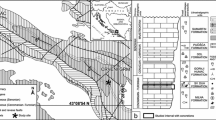Abstract
In a core from the outer Skagerrak, the content of biogenic opal is higher in Late Pleistocene (Younger Dryas) than in Holocene deposits. In terms of opal accumulation, rates are 1 g/cm2/1,000 y during the Holocene and five to ten times larger during the Younger Dryas. Intensive dissolution has greatly reduced the Holocene opal content and does not allow calculation of paleoproductivity. The intensity of opal dissolution is reflected by dissolution stages of both the diatomParalia sulcata and sponge spicules. The intensity of dissolution is negatively correlated to the sedimentation rate and appears to be controlled by silica-undersaturated environment on the sea floor and the uppermost sediment layer.
Similar content being viewed by others
References
Stabell B, Thiede J (1985) The physiographic evolution of the Skagerrak during the past 15,000 years: Paleobathymetry and paleogeography. Norsk Geologisk Tidsskrift 65:19–22
Stabell B, Werner F, Thiede J (1985) Late Quaternary and modern sediments of the Skagerrak and their depositional environment: An introduction. Norsk Geologisk Tidsskrift 65:9–17
Björklund KR, Björnstad H, Dale B, Erlenkeuser H, Henningsmoen KE, Hoeg HI, Johnson K, Manum SB, Mikkelsen N, Nagy J. Peterstad K, Quale G, Rosenquist ITh, Salbu B, Schoenharting G, Stabell B, Thiede J, Throndsen I, Wassmann P, Werner F (1985) Evolution of the Upper Quaternary depositional environment in the Skagerrak: A synthesis. Norsk Geologisk Tidsskrift 65:139–149
Wassmann P (1985) Accumulation of organic matter in core GIK 15530-4 and the Upper Quaternary paleo-productivity in the Skagerrak. Norsk Geologisk Tidsskrift 65:131–137
Thiede J (1985) Upper Quaternary accumulation rates of marine outer Skagerrak sediments: Core GIK 15530-4. Norsk Geologisk Tidsskrift 65:125–130
Müller G (1967) Methods in Sedimentary petrology. In: v. Engelhardt W, Füchtbauer H, Müller G (eds) Sedimentary Petrology, Part 1. Stuttgart Schweizerbart'sche Verlagsbuchhandlung
Koopmann B (1981) Sedimentation von Saharastaub im subtropischen Nordatlantik während der letzten 25000 Jahre. “Meteor”-Forschungsergebnisse, Reihe C 35:23–59
Björklund KR (1985) Upper Weichselian-Holocene radiolarian stratigraphy in the Skagerrak (NE North Sea). Norsk Geologisk Tidsskrift 65:103–106
Stabell B (1985) Diatoms in Upper Quaternary Skagerrak sediments. Norsk Geologisk Tidsskrift 65:91–95
Schrader HJ (1972) Kieselsäure-Skelette in Sedimenten des ibero-marokkanischen Kontinentalrandes und angrezender Tiefsec-Ebenen. “Meteor”-Forschungsergebnisse, Reihe C 8:10–36
Mikkelsen N (1980) Experimental dissolution of Pliocene diatoms. Nova Hedwigia 33:893–911
Kamatani A (1971) Physical and chemical characteristics of biogenous silica. Marine Biology 8:84–95
Hurd DC (1973) Interactions of biogenic opal, Sediment and seawater in the Central Equatorial Pacific. Geochimica Cosmochimica Acta 37:2257–2282
Heath GR (1974) Dissolved silica and deep sea Sediments. Society of Economic Paleontologists and Mineralogists spec. publ. 20:77–93
Calvert SE (1974) Deposition and diagenesis of silica in marine sediments. International Association of Sedimentologists spec. publ. 1:273–299
Lisitzin AP (1972) Sedimentation in the World Oceans. Society of Economic Paleontologists and Mineralogists Spec. Publ. 17:1–218
Lisitzin AP (1985) The Silica cycle during the last ice age. Palaeogeography, Palaeoclimatology, Palaeoecology 50:241–270
Broecker WS, Peng TH (1982) Tracers in the sea. Publication Lamont-Doherty Geological Observatory, Palisades, New York
Billett DSM, Lampitt RS, Rice AL, Mantoura RFC (1983) Seasonal sedimentation of phytoplankton to the deep-sea benthos. Nature 302:520–522
Gersonde R, Wefer G (in press) Sedimentation of biogenic siliceous particles in Antarctic waters (Atlantic sector). Marine Micropaleontology
Smetacek VS (1985) Role of sinking in diatom life-history cycles: ecological, evolutionary and geological significance. Marine Biology 84:239–251
Schink DR, Guinasso NL (1977) Effects of bioturbation on sediment-seawater interaction. Marine Geology 23:133–154
Mikkelsen N (1984) Diatoms in the Zaire deep-sea fan and Pleistocene palaeoclimatic trends in the Angola Basin and west equatorial Africa. Netherlands Journal Sea Research 17:280–292
Werner F (1985) Sedimentary structures and the record of trace fossils in Upper Quaternary marine Skagerrak deposits. Norsk Geologisk Tidsskrift 65:65–71
Schink DR, Guinasso NL, Fanning KA (1975) Processes affecting the concentration of silica at the sediment-water interface of the Atlantic Ocean. Journal Geophysical Research 80:3013–3031
Author information
Authors and Affiliations
Rights and permissions
About this article
Cite this article
Bohrmann, G. Accumulation of biogenie silica and opal dissolution in upper quaternary skagerrak sediments. Geo-Marine Letters 6, 165–172 (1986). https://doi.org/10.1007/BF02238088
Received:
Revised:
Issue Date:
DOI: https://doi.org/10.1007/BF02238088



